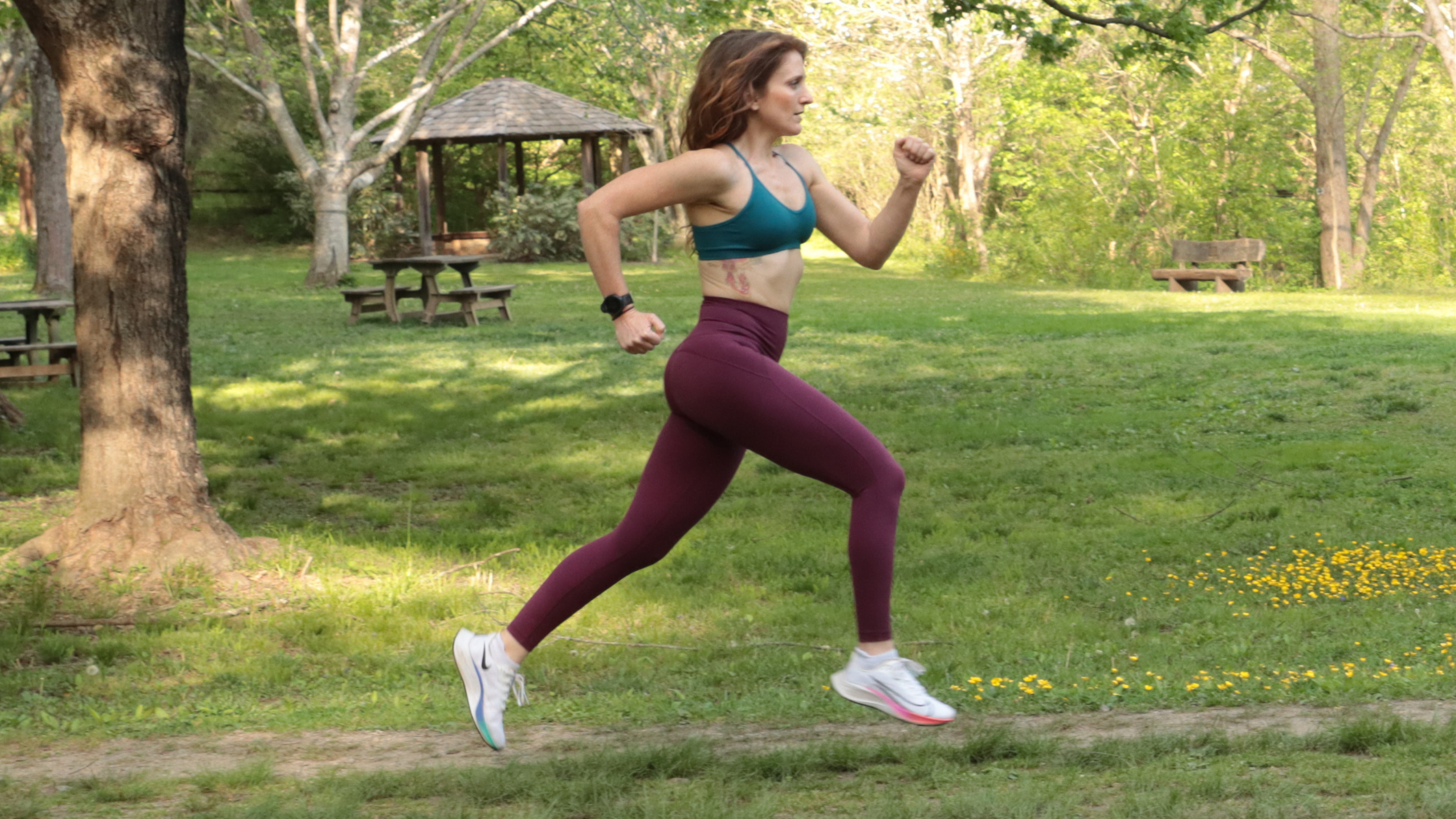Tempted to skip your running warm up? You’ll feel better and perform better if you invest a few minutes pre-run.
There is a saying in running that the first mile is a liar. You’ve just convinced yourself to go for a run and your body isn’t always going to be 100% on board with the idea. If it’s first thing in the morning, you might still be a little groggy. Or if you are an after-work runner, it’s likely that you are stiff and awkward from sitting at a computer all day.
But if you take a few minutes to warm up before you head out the door, even an easy run can feel better sooner. And if you are getting ready for a speed day or a race, a warm up is essential for performing your best.
I’ll explore why you shouldn’t skip a true warm up and explore exactly how to warm up for any kind of run or race.

Ease Into It
As we start to warm up the running muscles, blood and oxygen start flowing to power your run. Your joints and tendon sheaths start to become more limber and lubricated, making your run smoother, and lowering your chance of injury. If you start a race or fast workout without a good warmup, it’s kind of like revving the engine without any oil.
Not a great idea.
A Jog Isn’t Enough
Most runners think a mile or two of easy jogging is good enough for a warm up before a workout. And that might be okay, but about somewhere around 30-70% of runners get injured every year, so you might not want to automatically trust what most runners are doing. A good warm up will include some jogging, but it will also include some specific drills that will help you perform your best.
Prepare The Body For The Run
A running warm up does three things. First, it slowly prepares your body for the work you are about to do, literally warming up your muscles, by circulating your blood. Your heart rate gently rises and your breathing also gently increases. By the time you are ready for your faster paced running, your body is up to speed and it’s not so much of a shock.
Have you ever run up a flight or two of stairs only to find yourself out of breath at the top? You might say to yourself, “hey, I’m a marathon runner! Why on earth am I out of breath after climbing a flight of stairs?” The answer is that you were not warmed up. When you go from a full stop to top speed, your circulatory system is not yet fully engaged and the effort will feel much harder than if you have eased into it.
Build Neuromuscular Connections
The second thing a running warm up does is to build and reinforce the communication pathways between the brain and the muscles. These are called neuromuscular connections. Your running form, efficiency, economy, power, stride length, stride frequency and ultimately fatigue resistance – all of these are neuromuscular in nature. And they are not going to be developed just by jogging an easy warm up mile.
Neuromuscular training is about stimulating the brain’s communication with the muscles. To do that, we use specific drills that involve an element of concentration and a little bit of skill. Remember, we are trying to stimulate the brain and encourage it to communicate and activate more muscle fibers more quickly, with the goal of improving the efficiency of each stride. Simply going through the motions is not enough. Try to actively think about the muscles you are working with every movement.
Prepare Mentally
The third benefit to the running warm up goes beyond the physical. A good warm up routine prepares you mentally for what you are about to do. Before a race or big workout, it is normal to feel nervous, uncertain, or even a little unmotivated by the challenge. One of the best ways you can ease the negative mental energy is by channeling your focus into a routine that you’ve done a million times before. Even if you have doubts about how fast you are going to race that 5k, you can shift your mind’s focus into your familiar routine to quiet the negative self talk.
As you go through your specific sets of exercises, you can attach helpful mantras or sayings to each one. For example, if you do a high knees drill, you can repeat the word, “powerful, powerful, powerful,” every time you drive your knee up. If you do a few strides, you can say “relaxed fast,” over and over in your head until it’s second nature. The more you practice these powerful mind and body movements, the more natural they will come to you when you need them.
The Dynamic Warm Up
For an easy run, the best way to warm up is a dynamic warm up. Not only do they get you ready for the run, you are sneaking in some mobility work at the same time.
There are several classic drills that you can use in a dynamic warm up and they should only take a few minutes. The lunge matrix, which is doing 5-10 lunges on each leg forwards, backwards, and to the side, is a great place to start.
One of my favorite dynamic drills is leg swings. Find something to hold on to for balance and swing your leg forwards and backwards 8-10 times, then do it side to side and switch legs. This helps with your hip extension as well as focuses on lateral mobility. If you want to get your core involved a bit more, try doing them without holding on to anything.
This is also a great time to get in a little mobility and activation work for the particular areas that you are weak on. For example, if you have IT band issues, you can include hip drops. To do those, you stand with both feet sideways on a step and lower one leg a few inches down off the step, then switch sides. If you need some glute activation, add in a few donkey kicks or squat thrusts to wake them up.
Easy or Longer Tempo Runs
On an easy run, you can do these dynamic drills before you head out the door or you can choose to do them after a few minutes of easy jogging.
For a long run, a tempo run, or any kind of longer sustained run, warming up with some jogging and dynamic work is about all you need to start the run off right. Doing a bunch of intense drills before a long stamina run is probably going to wear you out more than you need for that kind of run.
Speed Days
For races and speedy days on the track, you’ll want to spend a little more time focusing on drills that enhance those neuromuscular connections that I mentioned before. The best kinds of drills for this are the ones that mimic running form, but in a highly exaggerated way. And because they are so focused on form and power, you’ll want to start them after you’ve gotten in a mile or two of easy jogging, but before you start your speedwork.

A great drill to start off with is strides. Strides are short, quick almost-sprints of about 10 to 20 seconds. Because you need to have great form to run your fastest, strides enhance your ability to run fast at all paces. Now to be clear, I said almost sprints, because you are not going all-out, max speed here. Keep them at around 85-90% of an all out effort. Remember this is just a drill, not a test, and you are just warming up. Try running about 4 strides, focusing on great form, with a complete walking or standing recovery for at least a minute to get your heart rate back down.
The rest of the speed-day drills include hopping, bounding, skipping, and fast feet drills. The better you get at these exaggerated versions of running, the better you will be at the real kind of running.
Once a week is about all most runners need for both short speed work and drills, which is great because they complement each other beautifully together.
Race Day Warm Ups
On race day, the length of your running warm up will have an inverse relationship to the length of your race. If you are racing the mile, for example, you’ll want to have a much longer warm up, with dynamic drills as well as speed drills to be sure that you are in peak form when the gun goes off.
For a marathon, you don’t want to spend too much time with the speed drills and waste too much of your energy. I recommend a 10-20 minute jog, a few dynamic drills, and maybe a few strides just to make sure everything is a go.
For the races in between, from 5k to half marathon, you’ll want to balance muscle activation with energy output, so again, the shorter the race, the longer the warm up and vice versa.
The Warm Up is Worth it!
I know that finding the time to get in a run, let alone a running warm up can be a challenge at times, but hopefully the extra few minutes that you’ll spend on dynamic drills and speed drills will be worth the extra effort. You’ll feel better on the run, be less injury prone, and with practice, run better and faster than ever.

